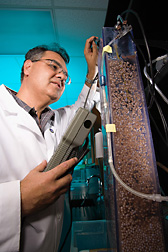This page has been archived and is being provided for reference purposes only. The page is no longer being updated, and therefore, links on the page may be invalid.
Read the magazine story to find out more. |
|
|
Reducing Nitrate Discharge to Downstream Ecosystems
By Ann PerryJanuary 27, 2009
Agricultural Research Service (ARS) scientists are finding ways to stem the flow of nitrates that are washed out of crop fields into regional surface and groundwater sources.
These nitrates come primarily from nitrogen fertilizers that are not taken up by crops. After the nitrates are flushed out of the soil, they flow into subsurface tile drains that channel excess water away from crop fields.
But these underground drains can facilitate the eventual passage of nitrate-laden runoff into the Gulf of Mexico, the Chesapeake Bay and other water bodies. When the runoff enters these areas, it can intensify the development of oxygen-deficient "dead zones," a condition called hypoxia.
ARS research leader Patrick Hunt, agricultural engineer Kenneth Stone, and soil scientist Matias Vanotti developed a process for denitrifying nitrate-laden runoff in subsurface drains before the runoff reaches sensitive aquatic ecosystems downstream. They cultured and encapsulated denitrifying bacteria in polymer gels and verified their denitrification rates. The resulting product was called "immobilized denitrification sludge," or IDS.
They then devised a bioreactor by placing the IDS into a small reactor cylinder. The team tested a bioreactor in the field, where nitrate concentrations in runoff averaged 7.8 milligrams per liter.
Hunt and ARS environmental engineer Kyoung Ro determined that the hydraulic retention time (HRT)--how long the field drainage water remained in the bioreactor--was crucial in the denitrification process. With a one-hour HRT, 50 percent of the nitrogen was removed from the runoff. When the HRT was increased to more than 8 hours, the nitrate removal efficiency approached 100 percent.
The team concluded that the daily nitrate removal rate of a one-cubic-meter bioreactor would be approximately 94 grams per square meter of nitrate from field runoff. This is significantly higher than removal rates reported for in-stream wetlands, treatment wetlands, or wood-based bioreactors.
Hunt, Ro, Stone, and Vanotti all work at the ARS Coastal Plains Soil, Water and Plant Research Center in Florence, S.C.
Read more about this research in the January 2009 issue of Agricultural Research magazine.
ARS is the principal intramural scientific research agency of the U.S. Department of Agriculture.

